New Page 2
..In the beginning...
While hanging out on Usenet's comp.sys.ibm.pc.games.strategic in 1992 college
student Brad Wardell was just one of many Usenet participants who put together
wish lists for their favorite games. What made Brad a bit different was
that he decided to do something about his wish list, he would make his own game.
One problem -- Brad didn't really know how to program (other than some Basic)
and was a poor artist. With little money, Brad bought "Teach Yourself C in
21 days" and decided to program the game for IBM's new OS/2 2.x operating
system.
OS/2 had two features that Windows lacked -- multithreading and memory
protection. It allowed him to make a game with a very robust computer AI.
While most games forced the user to sit and wait for the computer players to
create their strategy after they pressed the turn button, Galactic Civilizations
would be multithreaded -- its computer players would plan their strategy while
the player moved their units. As a result, the computer players were
significantly more clever and sophisticated than other games at the time.
Galactic Civilizations was probably the first retail game that made us of
multiple threads (the second retail game to make use of multiple threads was
called Avarice, also
released by Stardock and developed by Dave Pottinger, went on to become the lead
developer of Age of Empires III for Ensemble).
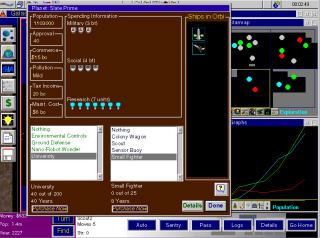
Planet screen for GalCiv for OS/2 (1994). As ugly as it is, bear in mind that
most games at the time were 320x200x16 colors.
In 1995, Stardock released a sequel to Galactic Civilizations (Galactic
Civilizations 2) which improved the the production values but was largely the
same game. A Galactic Civilizations 2 Gold was eventually released.
This was during the age where major updates couldn't easily be distributed
electronically.
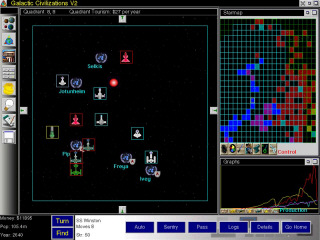
Galactic Civilizations 2 for OS/2 (1995)

Ship design from Galactic Civilizations OS/2 Gold (1996)
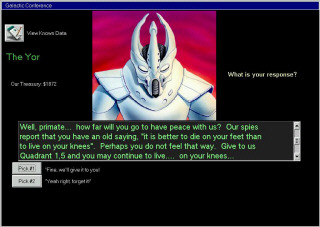
OS/2 Dies...
In 1997, OS/2 had clearly lost out to Microsoft Windows and Stardock's
network of OS/2 game developers dispersed in all different directions. One
developer went to Westwood. Dave went to Ensemble. Mike Duffy, who developed the
underling game library that every Stardock game until The Political Machine
used, went to work on Jimmy Neutron. And still others were laid off.
After Entrepreneur was
released in 1997, there was practically no Stardock game team. It was barely
alive. Only Brad remained along with Alex Gounaropoulos, an artist from
Entrepreneur who had re-tasked making content for Stardock's non-game projects
such as Object Desktop.
Stardock kept its finger in the game industry with projects such as Starcraft:
Retribution developed for GT Interactive & Blizzard Entertainment. It also
tried to license the Total Annihilation engine to create a game called
"Mobilization" that would later evolve into
Society. And most of all, Stardock was able to tweak and enhance
Entrepreneur into different titles -- Business Tycoon for Ubi Soft (which could
have been called Entrepreneur 1.5) and later
The Corporate Machine
(which could have been called Entrepreneur 2). A lawsuit with Entrepreneur
Magazine in 1998 ensured that Stardock would not go near using Entrepreneur as a
title again (it was settled out of court but essentially Stardock agreed to not
use the name in future games. At that time, Stardock was simply too small for
such a legal battle).
Phoenix
By 2001, Stardock's Object Desktop had become a hit. Programs such as
WindowBlinds gained millions of users
from around the world. Stardock had recovered from the OS/2 market and a
new Windows company had evolved.
Brad was interested in trying to bring Galactic Civilizations
back. In 2001, when the project got the go, the PC strategy game market
was supposedly in decline and turn-based gaming "d0med". So the budget was
kept fairly low. Stardock used the opportunity to start to rebuild its
game development team to prepare for larger projects if things went well.
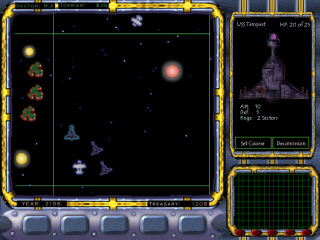
Early artist mockup of a potential GalCiv for Windows (2000 - artist left
Stardock to go work on "Prey" in 1999)
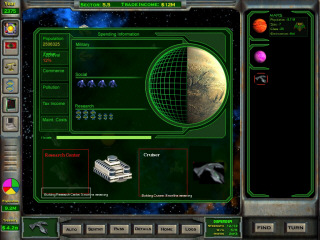
Early concept for the planet (2002)
In mid 2002 Stardock learned that a sequel to Master of Orion was in
development by Atari and that it had a multi-million dollar budget.
Fearing a direct competition, Stardock axed certain features that it felt would
not compare favorably such as ship design.
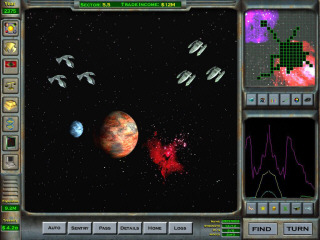
Main UI concept (2002)
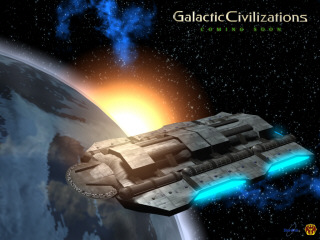
Early wallpaper
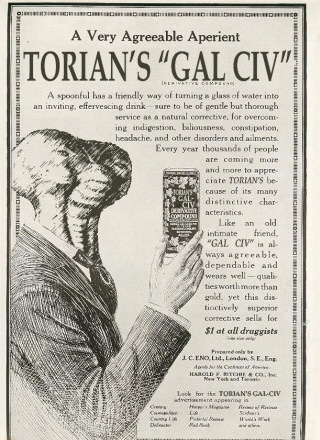 In
2003, Galactic Civilizations for Windows was released and it was a critical and
commercial hit. However, publisher Strategy First was facing financial
problems and much of the marketing and nearly all of the support ended up being
handled by Stardock. The financial problems at Strategy First also had a
major impact on Stardock itself: In
2003, Galactic Civilizations for Windows was released and it was a critical and
commercial hit. However, publisher Strategy First was facing financial
problems and much of the marketing and nearly all of the support ended up being
handled by Stardock. The financial problems at Strategy First also had a
major impact on Stardock itself:
When a person buys a $40 game a the store, the store pays roughly $30 to the
distributor. The distributor then pays roughly $20 to the publisher.
The publisher then takes out cost of goods sold and other misc. costs leaving
around $16. In theory, Stardock would then get $8 and Strategy First would get
$8. But Strategy First filed for bankruptcy and so much of the revenue was
never seen by Stardock.
However, Stardock had retained the direct sales rights and electronic
distribution rights. With its existing digital distribution system built
for Object Desktop, Galactic Civilizations became the first major retail game to
be released both at stores and digitally at the same time. Stardock went
on to sell tens of thousands of copies of the game digitally. This revenue
was then used to keep the game's team going.
The Next Wave
In 2004 Stardock designed and developed the PC game The Political Machine in
6 months. It was quite a feat given that it required the development of a 3D
engine, a match-making multiplayer client and server, and of course a game.
The game got mixed reviews as some reviewers felt the game was too light (it
was, after all, a casual $20 game, it's "competition" are various puzzle games).
CGW gave it 4.5 stars, Gamespy 4 stars, PC Gamer 73%. But sales were
very strong and it was very popular with users. Lesson learned -- budget
titles don't tend to review well but still can sell very strong. The
Political Machine outsold Galactic Civilizations in North America (it wasn't
ever released overseas).
The Political Machine was the last game that Stardock developed that it
didn't publish. Ubi Soft demonstrated an excellent talent for marketing
and distribution. But Stardock felt a loss of control over how the game was
handled (such as no European version, difficulty in doing updates, etc.).
But Stardock also learned that if it was going to do business in the game
industry to stick with large companies. Ubi Soft was a reliable partner
just as Take 2 (Which had published The Corporate Machine) had been.
When development began on Galactic Civilizations II at the end of 2004, it
was decided that Stardock would self-publish. Object Desktop and its other
non-games had become popular enough that the company was financially
independent. It could produce a Galactic Civilizations II on its own with
a AAA budget.
The game went through a number of designs. Ultimately the 3D engine
would be used to the max. Advanced lighting. Bump mapping. High resolution
textures. Everything that one would normally expect in a AAA first person
shooter or RTS would be there. The difficulty in having the ships look
good would be significant, however. Unlike in other games where the units
are all totally modeled by 3D designers in which the colors and shapes are
pre-designed, Galactic Civilizations II's units would have their look and feel
determined by the player. Colors, lighting, shapes, etc. This
required an engine that couldn't assume the hull would be a rusty brown.
The hull might be rusty brown or it might be pitch white or it might be blue.
Another requirement was the performance. Wardell set that the hardware
requirements for the sequel be roughly the same as for the original. Fast
speed would have to trump eye candy. "It has to look great and be really really
fast".
The ultimate test for this would be the map zooming. The game Black &
White featured an engine where players could seamlessly zoom out and see the
whole world and zoom in right down to see individual people. The game
engine in Galactic Civilizations was required to let people see a huge chunk of
the galaxy from incredible distances all the way down to being able to see
individual lakes on planets or individual windows on ships.
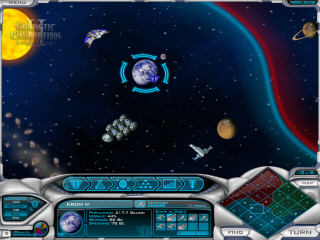
Early GalCiv II concept.
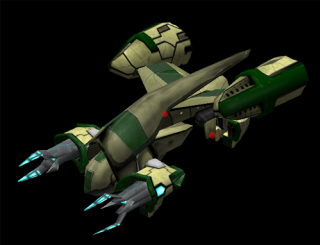
Early ship test
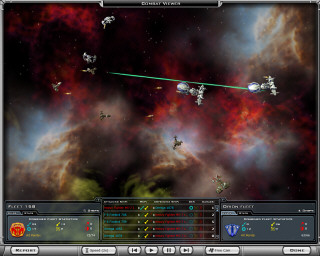
Ship battles evolved from a simple chart to full fledged battles like seen here.
The future..
Galactic Civilizations II was released on February 21st. Stardock
planned at least two expansion packs -- one for Fall 2006 called "Dark Avatar"
and another yet untitled. After that, most of the Galactic Civilizations
team would be on Society, Political Machine 2008, and an unnamed fantasy
strategy game. Eventually Stardock hopes to do a Galactic Civilizations
III.
It also hopes to leverage the popularity of Galactic Civilizations II to
boost TotalGaming.net and work with other indie game developers to bring their
games to market both digitally and at retail. Galactic Civilizations II
helped Stardock put in place the necessary logistics to do a major worldwide
launch of a major retail PC game.
Stardock's goal is that by the end of 2006 to have put completed putting
together 2 completely independent game development teams. The resources
are now in place, it's literally finding the right people (game developers, 3D
artists, modelers, etc.). If you are interested in joining Stardock,
contact amarshall@stardock.com.
It's located in Plymouth Michigan where it is 72 degrees (25C) all year round.
At the start of 2006, Stardock employs over 40 people worldwide with about 30
of them located in Plymouth Michigan. It is still privately held by Brad
Wardell.
Time Line
| 1992 |
College student Brad Wardell begins writing Galactic
Civilizations for OS/2 |
| 1993 |
Galactic Civilizations Beta 1 released
Master of Orion released |
| 1994 |
Galactic Civilizations released for OS/2
Shipyards for Galactic Civilizations released for OS/2 |
| 1995 |
Galactic Civilizations 2 released |
| 1996 |
Galactic Civilizations Gold released |
| 1996 |
Avarice released for OS/2 |
| 1997 |
Entrepreneur released for OS/2 |
| 1998 |
Entrepreneur released on Windows, first Windows game |
| 2001 |
The Corporate Machine released |
| 2003 |
Galactic Civilizations for Windows released |
| 2004 |
The Political Machine released
Galactic Civilizations: Altarian Prophecy Released |
| 2006 |
Galactic Civilizations II released |
|